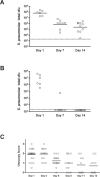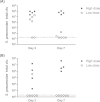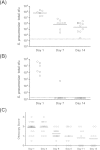Nonencapsulated Streptococcus pneumoniae causes otitis media during single-species infection and during polymicrobial infection with nontypeable Haemophilus influenzae
- PMID: 26014114
- PMCID: PMC4849347
- DOI: 10.1093/femspd/ftu011
Nonencapsulated Streptococcus pneumoniae causes otitis media during single-species infection and during polymicrobial infection with nontypeable Haemophilus influenzae
Abstract
Streptococcus pneumoniae strains lacking capsular polysaccharide have been increasingly reported in carriage and disease contexts. Since most cases of otitis media involve more than one bacterial species, we aimed to determine the capacity of a nonencapsulated S. pneumoniae clinical isolate to induce disease in the context of a single-species infection and as a polymicrobial infection with nontypeable Haemophilus influenzae. Using the chinchilla model of otitis media, we found that nonencapsulated S. pneumoniae colonizes the nasopharynx following intranasal inoculation, but does not readily ascend into the middle ear. However, when we inoculated nonencapsulated S. pneumoniae directly into the middle ear, the bacteria persisted for two weeks post-inoculation and induced symptoms consistent with chronic otitis media. During coinfection with nontypeable H. influenzae, both species persisted for one week and induced polymicrobial otitis media. We also observed that nontypeable H. influenzae conferred passive protection from killing by amoxicillin upon S. pneumoniae from within polymicrobial biofilms in vitro. Therefore, based on these results, we conclude that nonencapsulated pneumococci are a potential causative agent of chronic/recurrent otitis media, and can also cause mutualistic infection with other opportunists, which could complicate treatment outcomes.
Keywords: Haemophilus; coinfection; nonencapsulated; pneumococcus.
© FEMS 2014. All rights reserved. For permissions, please e-mail: journals.permissions@oup.com.
Figures






Similar articles
-
Mixed pneumococcal-nontypeable Haemophilus influenzae otitis media is a distinct clinical entity with unique epidemiologic characteristics and pneumococcal serotype distribution.J Infect Dis. 2013 Oct 1;208(7):1152-60. doi: 10.1093/infdis/jit289. Epub 2013 Jul 10. J Infect Dis. 2013. PMID: 23842949
-
Nontypeable Haemophilus influenzae as a pathogen in children.Pediatr Infect Dis J. 2009 Jan;28(1):43-8. doi: 10.1097/INF.0b013e318184dba2. Pediatr Infect Dis J. 2009. PMID: 19057458 Review.
-
Coinfection with Haemophilus influenzae promotes pneumococcal biofilm formation during experimental otitis media and impedes the progression of pneumococcal disease.J Infect Dis. 2010 Oct 1;202(7):1068-75. doi: 10.1086/656046. J Infect Dis. 2010. PMID: 20715928 Free PMC article.
-
Biofilm production by Haemophilus influenzae and Streptococcus pneumoniae isolated from the nasopharynx of children with acute otitis media.BMC Infect Dis. 2019 Jan 11;19(1):44. doi: 10.1186/s12879-018-3657-9. BMC Infect Dis. 2019. PMID: 30634919 Free PMC article.
-
Recurrent and persistent otitis media.Pediatr Infect Dis J. 2000 Sep;19(9):911-6. doi: 10.1097/00006454-200009000-00034. Pediatr Infect Dis J. 2000. PMID: 11001126 Review.
Cited by
-
Panel 7 - Pathogenesis of otitis media - a review of the literature between 2015 and 2019.Int J Pediatr Otorhinolaryngol. 2020 Mar;130 Suppl 1:109838. doi: 10.1016/j.ijporl.2019.109838. Epub 2019 Dec 19. Int J Pediatr Otorhinolaryngol. 2020. PMID: 31879085 Free PMC article. Review.
-
Type IV Pilus Expression Is Upregulated in Nontypeable Haemophilus influenzae Biofilms Formed at the Temperature of the Human Nasopharynx.J Bacteriol. 2016 Sep 9;198(19):2619-30. doi: 10.1128/JB.01022-15. Print 2016 Oct 1. J Bacteriol. 2016. PMID: 27044626 Free PMC article.
-
Molecular characterization of pneumococcal surface protein K, a potential pneumococcal vaccine antigen.Virulence. 2017 Aug 18;8(6):875-890. doi: 10.1080/21505594.2016.1278334. Epub 2017 Jan 6. Virulence. 2017. PMID: 28059611 Free PMC article.
-
A Moraxella catarrhalis vaccine to protect against otitis media and exacerbations of COPD: An update on current progress and challenges.Hum Vaccin Immunother. 2017 Oct 3;13(10):2322-2331. doi: 10.1080/21645515.2017.1356951. Hum Vaccin Immunother. 2017. PMID: 28853985 Free PMC article. Review.
-
Characterization of MSlys, the endolysin of Streptococcus pneumoniae phage MS1.Biotechnol Rep (Amst). 2020 Oct 24;28:e00547. doi: 10.1016/j.btre.2020.e00547. eCollection 2020 Dec. Biotechnol Rep (Amst). 2020. PMID: 33204659 Free PMC article.
References
-
- Bakaletz LO, Leake ER, Billy JM, et al. Relative immunogenicity and efficacy of two synthetic chimeric peptides of fimbrin as vaccinogens against nasopharyngeal colonization by nontypeable Haemophilus influenzae in the chinchilla. Vaccine. 1997;15:955–61. - PubMed
Publication types
MeSH terms
Grants and funding
LinkOut - more resources
Full Text Sources
Other Literature Sources
Medical

